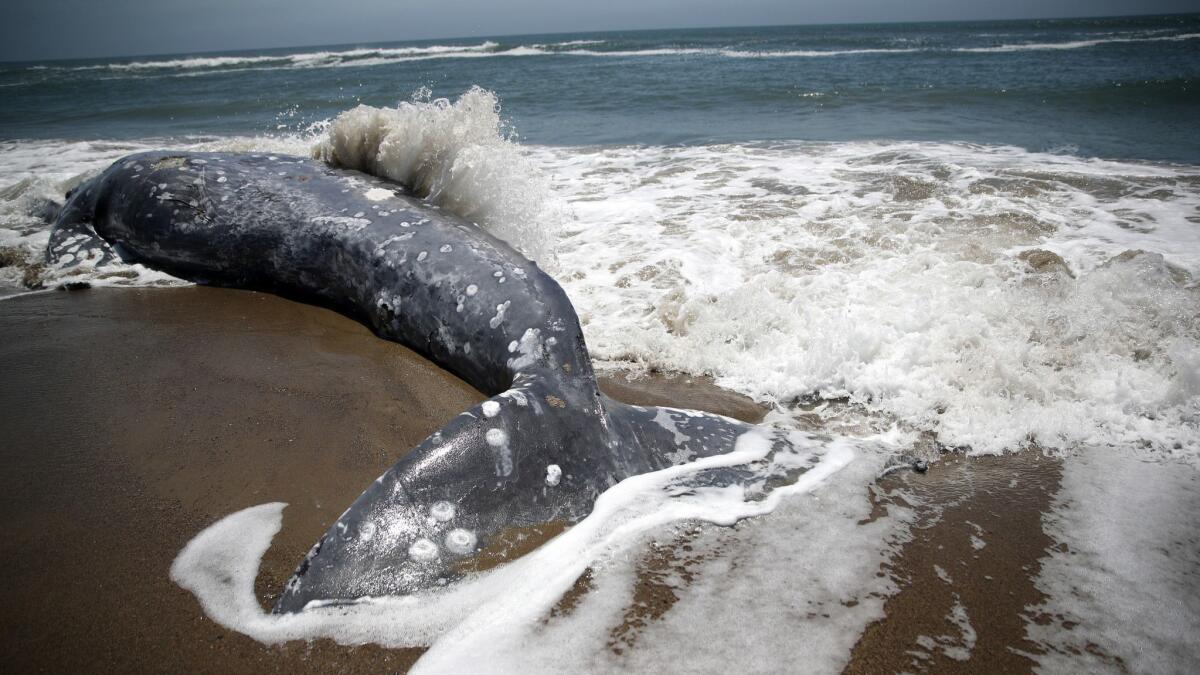Whales are dying, but numbers are unknown. Coronavirus has stalled scientific fieldwork

As gray whales began their northern migration along the Pacific coast, earlier this month — after a year of unusually heavy die-offs — scientists were poised to watch, ready to collect information that could help them learn what was killing them.
The coronavirus outbreak, however, has largely upended that field work — and that of incalculable other ecological studies nationwide.
A large network of marine biologists and volunteers in California normally spend this time of year keeping an eye on gray whales, documenting their numbers and counting strandings as the leviathans swim from Mexico to the Arctic.
Scott Mercer, who started Point Arena’s Mendonoma Whale and Seal Study seven years ago, said the watch was called off Wednesday, as he and his wife were told by a local sheriff to disperse and go home.
“I guess two people are now considered a public gathering,” he said, with a wry chuckle.
In Los Angeles, Alisa Schulman-Janiger said she had to shut her survey down March 20, meaning this will be the first time in 37 years that data on the northern migration will not be complete.
“We had to,” said Schulman-Janiger, director of the Los Angeles chapter of the American Cetacean Society. “We couldn’t hazard anybody’s health.”
Up and down the West Coast and beyond, field research on a variety of endangered, threatened and migrating species has ground to a halt. Plovers? Abalone? They are on their own now, as scientists are forced to stay at home.
Schulman-Janiger said that before her work was called off, she had noticed an unusually early migration, with several skinny whales.
Even more alarming, she said, were observations of moms with very small calves — baby whales that, to her eye, looked too small to be making a 5,000-mile trip north.
“They looked like newborns,” she said. “Like what you’d typically see in December or January. Not calves who’d just spent months nursing in the lagoons, getting stronger and bigger.”
Last year, 215 gray whales were stranded on North America’s Pacific coast as they migrated north, sparking a federal investigation into this unusual die-off event.
This year, 49 have been stranded, so far, in Mexico.
As local authorities close a growing number of parks and beaches, notifications and alerts about whale strandings and sightings will become increasingly erratic, she said, making it harder for researchers to know what is happening.
“Field teams may or may not respond to strandings and entanglements depending on the location and personnel availability,” said Michael Milstein, spokesman for the National Oceanic and Atmospheric Administration, adding that the agency is advising its partners “to follow the guidance provided by local, state, and federal authorities.”
It’s not just whales.
Hundreds of environmental and ecological monitoring projects are now on pause, creating marked data holes in several long-term analyses. And in some cases, there’s been a halt in the protection and vigilance of some endangered species, including the snowy plover.
The timing couldn’t be worse.
“It’s springtime,” said Andrea Jones, Director of Bird Conservation for Audubon California, noting this is when many birds nest and migrate. Research teams are stuck indoors, as are thousands of volunteers who take part in Audubon Society bird counts, vital for judging the health of annual bird migrations.
Elsewhere, in research labs and aquariums across California, scientists are scrambling to adjust their projects and conservation efforts — many of which are time sensitive to the seasons.
Plans to cull an ambitious number of purple sea urchins — aggressive creatures that have devoured the kelp forests in Northern California and crowded out most all other life on the seafloor — for instance, is in limbo pending stay-at-home restrictions.
Every University of California campus has closed its labs, and California’s coast and ocean research efforts have largely been suspended. Coastal officials have also lost critical assistance from numerous universities and colleges in monitoring the state’s fisheries and marine protected areas.
“The lack of data impacts everything from fisheries management to assessing the effectiveness of our marine protected area network,” said Mark Gold, executive director of the state’s Ocean Protection Council.
“The biggest challenge we’re facing is the planning for the unknown. So many ‘what ifs’ need to be considered,” Heather Burdick, director of marine operations at the Bay Foundation, said Wednesday.
The Bay Foundation, a research nonprofit, is usually out on the water several times weekly to restore kelp and feed the endangered species that scientists have been trying to reintroduce into the ocean. “Our team … call today was focused on contingency plans for contingency plans,” she said.







